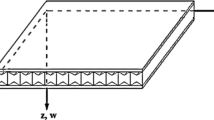Abstract
Impact forces applied to a steel-beam-reinforced concrete deck at various positions are reconstructed using an inverse algorithm based on dynamic signals captured using single-axis accelerometers. A deconvolution technique in the time domain utilising dynamic signals is adopted to reconstruct the impact force. Two deconvolution approaches are investigated, one with a transfer function in the convolution integral and the other without an explicit transfer function. The roles of the transfer function and regularisation are evaluated, addressing the efficiency of the methods and accuracy of reconstructed forces based on the coefficient of their correlation with the actual impact forces. The effects of some parameters on the accuracy of reconstructed impact force are studied, including the locations of impact and measurement points, the characteristics of reference impact force and the stiffness of impact hammer head.















Similar content being viewed by others

References
Khoo SY et al (2014) Impact force identification with pseudo-inverse method on a lightweight structure for under-determined, even-determined and over-determined cases. Int J Impact Eng 63:52–62
Inoue H, Harrigan JJ, Reid SR (2001) Review of inverse analysis for indirect measurement of impact force. Appl Mech Rev 54:503
Sanchez J, Benaroya H (2014) Review of force reconstruction techniques. J Sound Vib 333(14):2999–3018
Park J, Ha S, Chang F-K (2009) Monitoring impact events using a system-identification method. AIAA J 47(9):2011–2021
Akhavan SEW, Farhad KC (2000) Prediction of impact contact forces of composite plates using fiber optic sensors and neural networks. Mech Compos Mater Struct 7(2):195–205
Chandrashekhara K, Okafor AC, Jiang Y (1998) Estimation of contact force on composite plates using impact-induced strain and neural networks. Compos Part B 29(4):363–370
Jones RT, Sirkis JS, Friebele E (1997) Detection of impact location and magnitude for isotropic plates using neural networks. J Intell Mater Syst Struct 8(1):90–99
LeClerc J et al (2007) Impact detection in an aircraft composite panel—a neural-network approach. J Sound Vib 299(3):672–682
Jacquelin E, Bennani A, Hamelin P (2003) Force reconstruction: analysis and regularization of a deconvolution problem. J Sound Vib 265(1):81–107
Chang C, Sun C (1989) Determining transverse impact force on a composite laminate by signal deconvolution. Exp Mech 29(4):414–419
Wu E, Tsai C-Z, Tseng L-H (1998) A deconvolution method for force reconstruction in rods under axial impact. J Acoust Soc Am 104(3):1418–1426
Wu E, Tsai T-D, Yen C-S (1995) Two methods for determining impact-force history on elastic plates. Exp Mech 35(1):11–18
Doyle J (1987) Experimentally determining the contact force during the transverse impact of an orthotropic plate. J Sound Vib 118(3):441–448
Doyle JF (1997) A wavelet deconvolution method for impact force identification. Exp Mech 37(4):403–408
Martin M, Doyle J (1996) Impact force location in frame structures. Int J Impact Eng 18(1):79–97
Martin M, Doyle JF (1996) Impact force identification from wave propagation responses. Experiment Mech 18(1)
Boukria Z, Perrotin P, Bennani A (2011) Experimental impact force location and identification using inverse problems: application for a circular plate. Int J Mech 5(1):48–55
Wu E, Yeh J-C, Yen C-S (1994) Impact on composite laminated plates: an inverse method. Int J Impact Eng 15(4):417–433
Boukria Z et al (2012) Structural monitoring: identification and location of an impact on a structurally dissipating rock-shed structure using the inverse method. Europ J Environment Civil Eng 16(1):20–42
Hu N, FUKUNAGA H (2005) A new approach for health monitoring of composite structures through identification of impact force. J Adv Sci 17(1):82–89
Hu N et al (2007) An efficient approach for identifying impact force using embedded piezoelectric sensors. Int J Impact Eng 34(7):1258–1271
Hu N et al (2007) Identification of impact forces on composite structures using an inverse approach. Struct Eng Mech 27(4):409–424
Laš V et al (2012) Reconstruction of impact force on curved panel using piezoelectric sensors. Proc Eng 48:367–374
Park CY et al (2012) Localizations and force reconstruction of low-velocity impact in a composite panel using optical fiber sensors. Adv Compos Mater 21(5-6):357–369
Hansen PC (1994) Regularization tools: a Matlab package for analysis and solution of discrete ill-posed problems. Num Algorithms 6(1):1–35
Gunawan FE (2012) Levenberg–Marquardt iterative regularization for the pulse-type impact-force reconstruction. J Sound Vib 331(25):5424–5434
Inman DJ (2001) Engineering vibration. Prentice-Hall
Meirovitch L (1986) Elements of vibration analysis. McGraw-Hill
Thomas GB, Finney RL, Weir MD (1988) Calculus and analytic geometry. vol. 7. Addison-Wesley Reading, MA
Calvetti D et al (2000) Tikhonov regularization and the L-curve for large discrete ill-posed problems. J Comput Appl Math 123(1):423–446
Hansen PC (1998) Rank-deficient and discrete ill-posed problems: numerical aspects of linear inversion. 4. Siam
Calvetti D, Reichel L, Shuibi A (2004) L-curve and curvature bounds for Tikhonov regularization. Num Algorithms 35(2-4):301–314
Rezghi M, Hosseini SM (2009) A new variant of L-curve for Tikhonov regularization. J Comput Appl Math 231(2):914–924
Kalhori H (2014) Impact force reconstruction on a concrete deck using a deconvolution approach. 8th Australasian Congress on Applied Mechanics: ACAM 8. ACT: Engineers Australia, Barton, pp 763–771
Makki Alamdari M et al (2015) Spectral-based damage identification in structures under ambient vibration. J Comput Civil Eng:04015062
Author information
Authors and Affiliations
Corresponding author
Rights and permissions
About this article
Cite this article
Kalhori, H., Ye, L., Mustapha, S. et al. Reconstruction and Analysis of Impact Forces on a Steel-Beam-Reinforced Concrete Deck. Exp Mech 56, 1547–1558 (2016). https://doi.org/10.1007/s11340-016-0188-4
Received:
Accepted:
Published:
Issue Date:
DOI: https://doi.org/10.1007/s11340-016-0188-4



